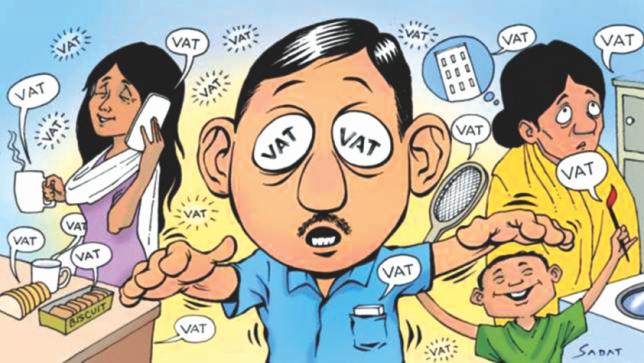Is VAT a regressive tax on the poor?
The share of value-added tax (VAT) in the national exchequer has continuously been creeping up ever since its introduction more than 27 years ago, and has increased in recent years to the point where it is the single biggest slice of revenue collections by the government. The latest budget just passed in the parliament amounts to Tk 4,64,573 crore of which tax revenue is Tk 3,39,200 and value-added tax is estimated at Tk 1,10,555, which is 36 percent of tax revenue receipts.
The above numbers depict a picture where VAT has become the most productive “milch cow” of the government for tax receipts and the National Board of Revenue is bent on gradually expanding the scope of VAT-able products, services and merchants to “milk” this further in the days ahead. Among the tax policy wonks, the perception is that the size of VAT collections based on the size of our economy could easily be double what it is today.
Given this emphasis on VAT as the fastest growing portion of tax revenue, the government has embarked on a comprehensive automation of VAT administration that has been afoot since 2015. Once this automation process is completed, taxpayers can expect easier compliance processes aided by online tax administration systems. Combined with computer-based VAT accounting systems at the taxpayer end, the automated VAT administration system, once fully available, is expected to usher in a VAT collection and reporting system that would be largely free from manual interventions and discretionary oversight. Businesses that maintain full-disclosure automated accounting systems should find themselves free from compliance hassles and overwrought tensions of discretionary rulings. This, however, is the realm of process optimisations and information technology solutions that will carry out whatever taxation policies are put in place under the VAT regime.
VAT is a multi-stage tax that is collected at the import, manufacturing, wholesale and retail stages of goods transactions and for service transactions at the consumption stage. For goods, even though the tax is collected at multiple stages, the brunt of the tax is borne by the retail consumer in the end, as taxpayers of earlier stages are allowed to claim credit for VAT paid earlier once the later stage tax is accounted for. In other words, for both goods and services, the consumer at the end of the chain pays the bulk of taxes.
Rich people consume a lower share of their income for subsistence than do poor people who often consume all their income just to survive. Since VAT is essentially a consumption tax in the end, one can easily see that poor people end up paying much more VAT as a share of their income than do rich people. In that sense, VAT certainly seems like a regressive tax, that is, you tend to pay proportionately more as your income level goes south. That, however, hasn’t prevented more than 40 of the largest economies in the world, accounting for more than 80 percent of world GDP, to adopt VAT as a central pillar of tax revenue. To assuage the negative impact of VAT on subsistence-level consumption, many countries, including Bangladesh, exempt basic foodstuffs such as grains, edible oil, and fresh produce from VAT. Another way VAT is made more bearable for those who earn less is by offering a truncated rate on certain types of consumption such as basic utilities or house rents below a certain ceiling. These measures make VAT accounting and receipts more daunting but they do provide tax relief to those at the bottom of the socio-economic pyramid.
It is significant in that sense that the latest budget proposal, just passed by the parliament, has truncated the rate of VAT on Internet—a basic utility these days—to 5 percent which is a third of the previous rate of 15 percent. This is a momentous policy shift which will have a highly positive impact on students and lower-income people. We would also like to see VAT on other utilities slashed in a similar fashion which, needless to say, will help alter the regressive nature of VAT as a tax implement.
The 2012 VAT and Excise Law envisioned a VAT ecosystem mandated on a single rate of 15 percent at all stages of collection (except for those goods and services that are exempted from VAT) and proposed abolishing the truncated system of VAT rates. Over the last six years, there has been a lot of hue and cry over this, and in the end, the government has opted to retain the system of truncated rates, though slightly streamlined to reduce the number of slabs from six to four. This will undoubtedly help diffuse the misgivings among small traders and manufacturers who were highly sceptical of their ability to comply with full-disclosure accounting systems overnight.
But the biggest benefit of retaining the system of truncated rates is neutralising the regressive tax pressure of VAT on small and medium enterprises (SME) as well as on consumption by the bottom half of the populace. In that sense, the budgetary direction given for VAT is a highly progressive measure and the government must be thanked for making it happen.
In the medium term though (2-5 years), VAT compliance shall become commonplace by default due to fully automated VAT administration system at the NBR end, and fully automated VAT accounting systems at the taxpayer end, which shall enable full-disclosure account reporting across the economic value chain. Once the country reaches that stage, perhaps then, and only then, a single rate of VAT may be possible across all sectors and stages of production and consumption. Even then, goods, utilities and services essential for subsistence will need to be kept out of VAT reach.
Habibullah N Karim is an author, policy activist, investor and serial entrepreneur. He is a founder and former president of BASIS and founder/CEO of Technohaven Company Ltd.
Source: The Daily Star.

